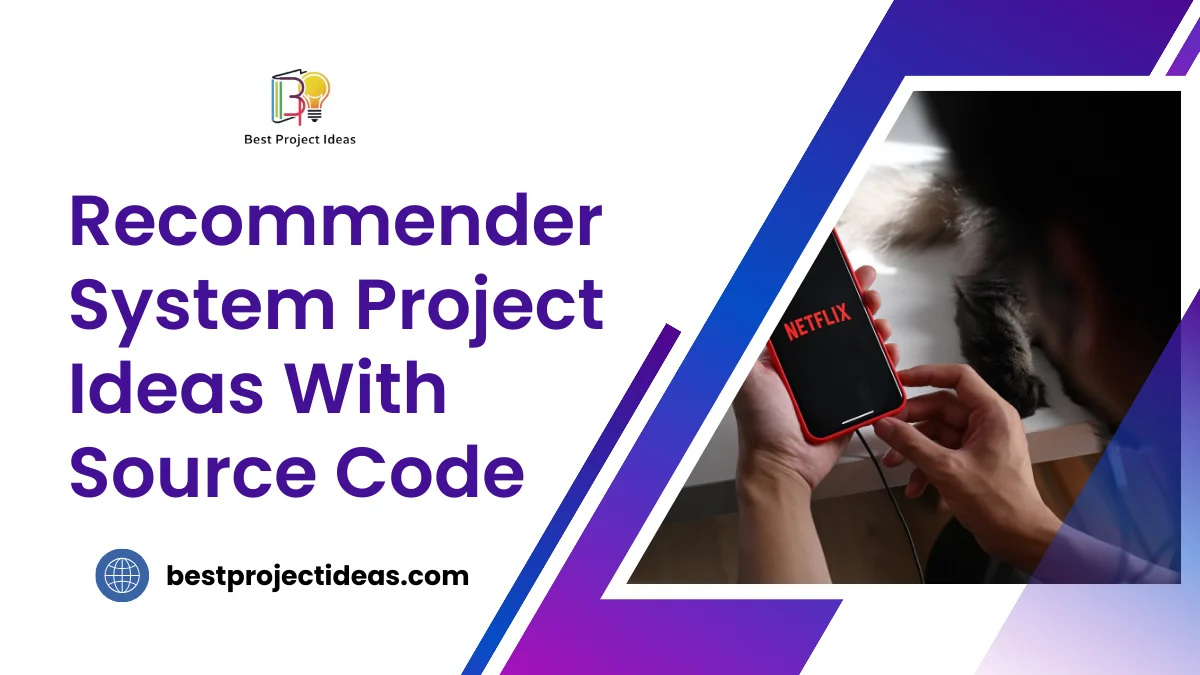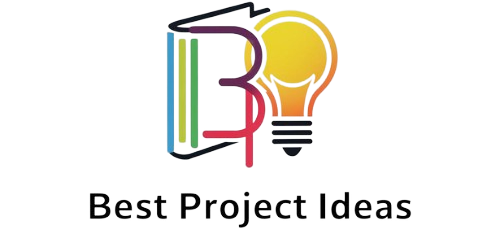
Recommender system project ideas with source code are great for learning how computers suggest things we might like. These projects show us how websites and apps decide what movies, music, or products to recommend. By trying these ideas and looking at the code, we can understand how recommender systems really work.
It’s fun to create our own system that can guess what someone might enjoy. These projects can be simple or more complicated, depending on what we want to learn. They’re a cool way to use math and coding to solve real-life problems. Let’s find out “Recommender system project ideas with source code in 2025”.
Must Read: 71+ Trending CAS Project Ideas For Students (Updated 2025)
What Is A Recommender System Practical Example?
Netflix’s movie suggestion feature is a practical example of a recommender system. It keeps track of what you have watched and takes note of the types of shows that appeal to you the most. It makes a list suggesting new movies or shows after going through preferred items among other people who have similar tastes.
This helps users find content they’ll probably enjoy without searching through everything, saving time and making watching more fun. Netflix has an elaborate mathematical formula for this, but the idea is simple: recommend things you might like on the basis of what you already love.
Companies also adopt similar models like Amazon always proposes, Spotify recommends while YouTube suggests videos that may interest someone. They all use the same method by predicting your preferences based on what you’ve liked in the past as well as those liked by other users with analogous taste.
Amazing Recommender System Project Ideas With Source Code For Students In 2025
Here are the top-level recommender system project ideas using python with source code for students:
- Movie Picker: Recommends movies based on your watching habits, favorite genres, and ratings. It uses collaborative filtering to suggest films that similar users enjoy.
Source: GitHub – Microsoft/Recommenders
- Book Finder: Helps you discover new books by analyzing your reading preferences, favorite authors, and book ratings. It combines content-based and collaborative filtering techniques.
Source: GitHub – zygmuntz/goodbooks-10k
- Music Matcher: Picks songs you might like based on your listening habits, preferred genres, and artists. It uses audio features and user behavior data for personalized recommendations.
Source: GitHub – caserec/CaseRecommender
- Restaurant Guide: Shows eateries you might want to try based on your food preferences, location, and past dining experiences. It considers factors like cuisine type, price range, and user reviews.
Source: GitHub – Coder-Yu/RecQ
- Travel Planner: Offers trip ideas based on your past vacations, budget, and interests. It uses collaborative filtering and content-based methods to suggest destinations, hotels, and activities.
Source: GitHub – Microsoft/Recommenders
- Shopping Helper: Suggests items you might want to buy by analyzing your purchase history, browsing behavior, and product ratings. It uses item-to-item collaborative filtering and matrix factorization.
Source: GitHub – tensorflow/recommenders
- News Feed: Picks articles you’d find interesting based on your reading history, topics you follow, and time spent on different news categories. It uses content-based filtering and natural language processing.
Source: GitHub – grahamjenson/list_of_recommender_systems
- Job Finder: Matches you with work you’d be good at by analyzing your skills, experience, and career goals. It uses content-based filtering and machine learning to suggest relevant job openings.
Source: GitHub – Microsoft/Recommenders
- Friend Suggester: Finds people you might want to know based on mutual friends, shared interests, and social network analysis. It uses graph-based algorithms and collaborative filtering techniques.
Source: GitHub – Coder-Yu/RecQ
- Game Recommender: Suggests video games you’d enjoy playing by analyzing your gaming history, preferred genres, and playtime. It uses hybrid filtering methods for personalized recommendations.
Source: GitHub – caserec/CaseRecommender
- Recipe Advisor: Offers meal ideas based on your dietary preferences, cooking skill level, and available ingredients. It uses content-based filtering and ingredient substitution algorithms.
Source: GitHub – Microsoft/Recommenders
- Pet Matcher: Helps find pets that fit your lifestyle by considering factors like living space, activity level, and allergy concerns. It uses decision trees and content-based filtering.
Source: GitHub – tensorflow/recommenders
- Course Picker: Suggests classes you might want to take based on your academic history, career goals, and learning style. It uses collaborative and content-based filtering techniques.
Source: GitHub – Microsoft/Recommenders
- Fitness Coach: Recommends workouts based on your fitness level, goals, and available equipment. It uses machine learning to create personalized exercise plans and track progress.
Source: GitHub – Coder-Yu/RecQ
- TV Show Finder: Suggests shows similar to ones you enjoy by analyzing plot themes, cast, and user ratings. It uses content-based filtering and natural language processing techniques.
Source: GitHub – caserec/CaseRecommender
- Podcast Discovery: Finds new podcasts you might like based on your listening history, preferred topics, and episode length. It uses collaborative filtering and audio feature analysis.
Source: GitHub – Microsoft/Recommenders
- Art Explorer: Suggests paintings or sculptures you’d appreciate by analyzing your art preferences, favorite artists, and historical periods. It uses image recognition and content-based filtering.
Source: GitHub – tensorflow/recommenders
- Clothing Stylist: Picks outfits based on your body type, style preferences, and occasion. It uses image recognition and collaborative filtering to suggest clothing combinations.
Source: GitHub – Coder-Yu/RecQ
- Home Decor Helper: Suggests furniture and decorations you’d like based on your design style, room size, and budget. It uses image analysis and content-based filtering techniques.
Source: GitHub – Microsoft/Recommenders
- Language Learning Buddy: Recommends words to study next based on your current vocabulary level, learning goals, and past performance. It uses spaced repetition algorithms and natural language processing.
Source: GitHub – caserec/CaseRecommender
How Do You Create A Recommendation System Model?
As we all know, creating a recommendation system can be a fun project. It’s like building a smart helper that suggests things people might like. If you want to make one, you’ll need to follow a few steps. Let’s look at how you can do this:
- Gather data: Collect information about what people like and don’t like.
- Choose a method: Decide how to sort and match the data.
- Train the model: Teach your system to find patterns in the data.
- Test it out: Check if your system makes good suggestions.
- Tweak and improve: Make changes to help it work better.
- Put it to use: Let people try your system and see how well it does.
With these steps, you can build a system that helps people find new things they might enjoy. It’s a bit like being a matchmaker, but for stuff instead of people. The more you work on it, the better it gets at making good suggestions.
How to Choose the Best Recommendation System Project Ideas?
Here are some ideas for choosing recommendation system projects:
Choosing Good Recommendation System Projects
- Look at your interests
Think about what you like. Choose something you enjoy, such as movies, books, or food.
- Consider available data
Make sure you can get the information you need. Find datasets with lots of user ratings or reviews.
- Start simple, then grow
Begin with an easy project. As you learn more, you can make it fancier or try harder ideas.
- Think about helping people
Focus on making something useful. Ask yourself how your project could make life easier for others.
These tips can help you pick a recommendation system project that’s fun and doable. Start small, use data you can find, and aim to create something helpful.
Sources To Find The Best Recommendation System Project Ideas
Here are some places to find ideas for your next recommendation system project:
Sources for recommendation system project ideas:
- Academic journals
Look at research papers in computer science and data science journals. They have new ideas you can use.
- Industry blogs
Companies like Netflix and Amazon talk about how they recommend things. Their blogs can give you good ideas.
- Online course platforms
Sites like Coursera and edX have courses where you can learn by doing projects. Look for data science courses for project ideas.
- Developer forums
Places like Stack Overflow have discussions about interesting recommendation problems. These can give you cool ideas for projects.
With these sources, you’ll find lots of fun ideas to think about. Happy thinking!
Final Words
Recommender system project ideas with source code can help you create interesting projects. You can build a movie picker or a book finder. These projects show you how computers choose things people might like. Making your own recommender is enjoyable and teaches you a lot.
You can find code online to help you get started. Experiment with different ideas to see what works best. The more you practice, the better you’ll become at building recommenders. These projects are great for learning and can even be useful in real life. So choose an idea and start building your own recommender system!
FAQs
Where can I find datasets for recommender system projects?
Look on websites like Kaggle or MovieLens for free datasets. Many universities also share public datasets for research.
What programming language is best for recommender systems?
Python is popular because it has libraries like Pandas and Scikit-learn that are helpful. But you can also use R or Java depending on what you like.
How do I evaluate the performance of my recommender system?
Use metrics like Mean Absolute Error or Precision at K. Also, try your system with real users to get practical feedback.

